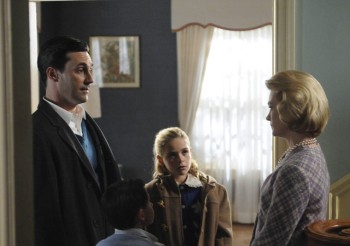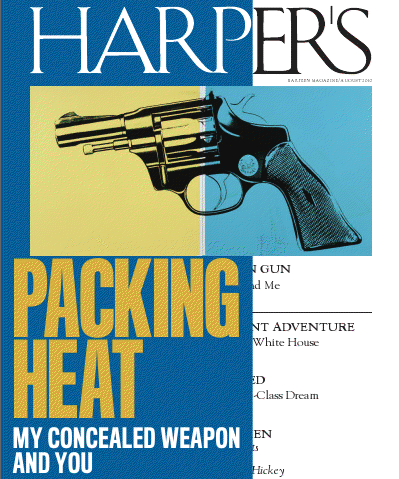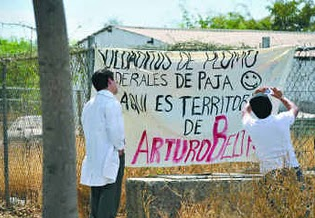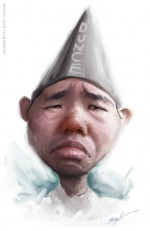When PR Goes Wrong: The MAC-Rodarte Fiasco

So not long ago now, the cosmetics manufacturer M·A·C and fashion label Rodarte teamed up to… no, really. Sell cosmetics, I was going to say. And then I was going to add their own phrase, “inspired by.” But then I just had to stop for a second, because it ain’t easy to complete this sentence, because what the sisters Mulleavy of Rodarte were allegedly “inspired by” is the border city of Juárez, Mexico. As Style.com’s Nicole Phelps explained back in February about the Rodarte Fall/Winter 2010 collection, “[T]hey became interested in the troubled border town of Ciudad Juárez; the hazy, dreamlike quality of the landscape there; and the maquiladora workers going to the factory in the middle of the night.” For serious.
And:
The show ended with a quartet of ethereal, unraveling, rather beautiful white dresses that alternately called to mind quinceañera parties, corpse brides, and, if you wanted to look at it through a really dark prism, the ghosts of the victims of Juárez’s drug wars.
The names of the M·A·C Rodarte cosmetics that were to go on sale this fall-blush, lip gloss, eyeshadows and nail polish, and so on-included “factory,” “Juárez,” “Ghost town,” “del Norte” and “quinceañera.”
Maybe it was overreacting, to be appalled by this news? Maybe the Mulleavys and their colleagues were not really really intending to glamorize the violence and bloodshed and horror of life in that sad and dangerous town. Oh yes, well then, take a gander at the models-and the makeup.

All hell started breaking loose, a lot of bloggers wrote about it and then, around the 16th of June, M·A·C and Rodarte issued these statements! That are crazy!
Just thinking about the number of people who have to have been involved in this product development, who have to have known about it, is disturbing. Did any of them speak up, as this product was being designed, packaged, prepared for market? Did anyone figure out to say, this stuff we are making here, that you put on your FACE, you know, it looks like blood. It suggests carnage, blood, in the desert, blood of abducted, raped, strangled women? Does it suggest that to you, a little bit?
Apparently, no.
M·A·C Cosmetics Statement:
We understand that product names in the M·A·C Rodarte collection have offended some of our consumers and fans. This was never our intent and we are very sorry. We are listening carefully to the comments posted and are grateful to those of you who have brought your concerns to the forefront of our attention. M·A·C will give a portion of the proceeds from the M·A·C Rodarte collection to help those in need in Juarez. We are diligently investigating the best way to do this. Please be assured that we will keep you posted on the details regarding our efforts.
Rodarte Company Statement:
Our makeup collaboration with M·A·C developed from inspirations on a road trip that we took in Texas last year, from El Paso to Marfa. The ethereal nature of this landscape influenced the creative development and desert palette of the collection. We are truly saddened about injustice in Juarez and it is a very important issue to us. The M·A·C collaboration was intended as a celebration of the beauty of the landscape and people in the areas that we traveled.
Okay, yes! Fine. We made our makeup look like blood because it is a celebration of the beauty. So, now that’s cleared up, right?
No! OMG, people were still mad!! So on or about July 19th, M·A·C announced that they were going to change the names of this stuff, that you put on your face, and also “donate $100,000 to an organization that helps women in Juarez.”
And then everyone calmed down-oh wait! No sorry, still no! Fury still raging unabated for entitled materialist horrorshow! Finally, on Friday, M·A·C issued another a press release explaining that now, all profits from the M·A·C Rodarte collection will go to “a newly created initiative to raise awareness and provide on-the-ground support to the women and girls in Juarez.”
Evidently they went clear to Mexico in order to try to recover a shred or two of dignity; even the tone of this press release grows humbler:
…M·A·C and Rodarte are deeply sorry that this makeup collection was so offensive to the people of Mexico and concerned global citizens.
This announcement follows a meeting last evening in Mexico City with M·A·C executives and Mexican government officials, including CONAVIM (Comisión Nacional Para Prevenir y Erradicar la Violencia Contra las Mujeres/National Commission to Prevent and Eradicate Violence Against Women.)
During the meeting, held at the Mexican Ministry of Foreign Affairs, this collective group committed to working together on the overall direction of the new initiative to help the women and girls of Juarez and to raise global awareness of their plight. M·A·C executives reiterated their deep regret and reinforced that it was never M·A·C’s or Rodarte’s intent to minimize the suffering of the women and girls of Ciudad Juarez.
So, if the strategy of giving 100% of their profits to charity also fails to repair their shattered image, one is forced to wonder whether M·A·C and Rodarte are planning to step in and do something about Mexican police corruption, next. After that, if necessary, maybe they can turn their attention to the crooked elections, and finally the drug cartels.
The cliché view of fashion insiders as shallow and uninformed remains completely undisturbed by this fiasco. The disconnect between the actual facts on the ground in Juárez and these surreal press releases and the reactions from the fashion press they spawned could not be more eye-crossing.
Nobody at Rodarte seems to have objected to anything about the Style.com review of their show back in February, which directly referenced Juárez; there was no outcry from the fashion press at that time, that I could find. It’s only when M·A·C started passing out the press releases to a larger public that a multitude of hackles went up. Indeed, the objections of quite a number of “concerned global citizens” have been met with outright mockery on the New York magazine fashion blog The Cut and elsewhere.
This is a pity. In times past there have been very cultivated, well-informed men and women in charge of the schmattas. I’d go so far as to say that the ideal of the fashion world used to represent a union of taste and intelligence; and really, is is possible to have one without the other? Where is the Cecil Beaton of today? The Christian Dior, the Diana Vreeland?
And is it remotely possible that the Mulleavy sisters were trying to make a Guernica-like statement with their art? It is possible. Except… they’ve responded to the criticism by backpedaling furiously, which says something about the authenticity or seriousness of the original statement. So maybe it’s as simple as it looks: for Rodarte to exploit the catastrophe in Juárez in order to sell dresses and makeup demonstrates the dehumanizing effects of a debased, pathologically materialist society that has evidently gone clean off the rails. It would be easy to make that observation and dismiss the whole affair.
It’s worth asking, though: what is really going on when violence and horror are appropriated in order to create a consumer product? Because quite often the makers of newpapers, books and films are involved in creating consumer products based on real horror, just as these raggers tried (and failed) to do.
To take this comparison to an extreme, let’s consider the novel 2666, by the late Roberto Bolaño. This book, like the M·A·C Rodarte makeup, is both a comment on the Juárez femicides and a consumer product.
The Part About the Crimes, the fourth section of 2666, is something like a catalogue of the femicides, deliberately dry, without poetry. It’s more or less a list of bodies, with details of their height, their hair color, their clothes, written with a police-procedural air. It is punishing to read, the longest part of a long book, written in deliberately ugly, dull prose; this, from a man capable of the utmost inventiveness, wit and penetration. So what’s the difference between selling eyeshadow “inspired by” these terrible events, and writing a novel about them?
I submit that the difference is one of vanity. Rodarte was posing alongside the victims of Juárez, in a way, asking you to be shocked and titillated by the real live goth corpses, the disturbing juxtaposition of horror and beauty. But nothing was meant to change in Juárez or anywhere else as the result of this aestheticized rubbernecking. Bolaño, on the other hand, wasn’t asking anything at all (aside from asking that you read his book.)
2666 isn’t a call to arms. It offers nothing in the way of judgments, let alone solutions. There’s no self-aggrandizement, no style; the author of 2666 has erased himself right out of the picture, leaving just a mirror of the human condition for you to look in. This is a matter of telling the truth, a deliberate avoidance of the “sensational.” Where Rodarte attemped to steal the terrible emotions evoked by the fact that hundreds, maybe thousands of girls have been abducted, raped and murdered in Juárez, and trivialize (and then, “monetize”) those emotions by turning them into eyeshadow, Bolaño asks that you stop being horrified, and just look at the truth; nothing more. What happens afterward is left for us to determine.
Maria Bustillos is the author of Dorkismo: The Macho of the Dork and
Messy Lives Are Actually Not That Alluring, Katie Roiphe
by Peter Birkenhead

Lock up your daughters: Kate Roiphe is waxing nostalgic again. In her latest paean to the Days of Wine and Date Rape, a piece in Sunday’s New York Times entitled “The Allure of Messy Lives,” Roiphe wonders if the popularity of the AMC series “Mad Men” is a sign that we all secretly miss the “fun” of swapping spouses, harassing employees, and getting blackout drunk at the office. In her usual “I’m just saying” style, Ms. Roiphe allows that “it’s hard” to defend alcoholism and infidelity, (and “harder still” to defend the far greater sin of smoking,) but, in the name of eulogizing the vital “intensity” so many old, rich, white men once got out of abusing their wives, families, livers and lungs, she apparently felt compelled to do so.
According to Roiphe, those of us raised by alcoholic, philandering wife-beaters might think we’re getting plenty of intensity out of, say, our marriages, or throwing dinner parties for our friends or taking vacations with our families, but what we’re actually doing is living deluded, timid lives steeped in a “malaise and alienation” no better than Don Draper’s. And yet we should envy him, for his struggle against “bourgeois ordinariness.” Has she seen “Mad Men”? I’ll admit that there are a few things I envy about Don Draper, but desultory sex in a shit-brown apartment with a hooker who smacks me in the face while my kids eat Thanksgiving dinner at their new Daddy’s place isn’t on the list. And is it anybody’s idea of class struggle? Where does Katie Roiphe get this stuff?
The first answer seems to be: from her mother’s Rolodex. In bolstering her case, she gathers an impressive array of two voices-both from her mother Anne’s narrow circle of literary and media contemporaries-to sing the praises of the fun old days. And not just any voices, but ones that, when it comes to being mad men, make Don Draper look like Don Knotts. First up for the defense is none other than Gay Talese, author of Thy Neighbor’s Wife, the notorious, near-career-killing, 1970’s chronicle of the married father’s own “casual research” into his effusive sexual entitlement.
Sounding like an aging Southern belle wistfully recalling the days of antebellum refinement, he remembers seeing “copy girls” slipping out of offices for trysts in hotels “with more than one man,” and says, “You didn’t have the word ‘exploitation’ then. And mostly it wasn’t exploitation.” Well, I know I feel better. It wasn’t “exploitation,” it was fun! See, if only today’s “copy girls” could shake off their prudish aversion to what Roiphe admiringly calls the “flagrant flirtation and cocktail party atmosphere of Sterling Cooper,” they too might get lucky once in a while. Coercive, gang-bang lucky! Who doesn’t miss that?
And today’s straight-laced guys just need to get over their fear of alcohol-induced comas. Roiphe makes the point that if modern men would give in to “the glamour of spectacularly messy, self-destructive behavior,” they might one day have memories as colorful as Talese’s recollection of “coming back from lunch one day and seeing one guywith his head flat down on his typewriter. No one touched him for hours, and eventually he woke up.” See! He woke up! Eventually. C’mon, you pantywaists-put down that infant son and try something really challenging, like typing with your face.
To be fair, Roiphe does describe modern life as “better, saner, more sensible,” than it was in the early 1960’s, but only to decry the “puritanical frisson” we get from feeling superior to the characters on “Mad Men.” She doesn’t do that argument any good, though, when, she quotes Jerry Della Femina, the advertising legend and publisher. It’s in Della Femina’s stories about the 60’s that Roiphe notices the word “fun” coming up so often, and she worries that we’re no longer “hanging out with the same boozy fluidity… the wild bursts of bad behavior” enjoyed by guys like Della Femina, who recently said about the Tiger Woods scandal, “let’s face it, bimbo-gate is going to be gone and people will forget it…. Every one of these women look like they escaped from the bunny ranch in Nevada.” Tiger was just having boozy, fluidy fun, people. Don’t be such stick-in-the-muds.
Roiphe’s final witness for the defense of terribleness is her mother, whose coming memoir, about “the literary circles orbiting the Paris Review,” produces this lament from her daughter: “I was struck by how much these productive and famous people drank. Today we would dismiss all of these brilliant, narcissistic artists and writers as alcoholics, the word itself carrying its own antiseptic morality, its own irrefutable argument for balance and sobriety, but back then they were simply charismatic.”
See, they weren’t just productive, (by which I mean “until they died very young,”) they were famous. And charismatic. What’s a few marriages compared to an invitation to the Plimptons’? Just look at all the romance we’ve given up by using words like “alcoholic.” It reeks of puritanical compassion for the sick, doesn’t it? And dreary old notions about protecting their wives and children. I mean, how
un-Don Draper can you get?
Roiphe is titillated by a passage in her mother’s book about parties where, “There was a flow to an evening, a sort of dangerous possibility in the air, that would be entirely foreign at the equivalent party now, at which most people go home with the person they are supposed to go home with.” And this to me is the saddest thing about Roiphe’s piece-how, well, sad it sounds. Where has she gotten the positively “Mad Men”-era idea that “embracing the responsibility” of marriage precludes a messy, exciting-sometimes even transcendentally so-life? Does Roiphe not get that, in her creaky old (and exceedingly bougie) critique of “bourgeois culture,” she sounds like one of the be-goateed trust-funders Don meets during the first season of the show? Exactly which “bursts of bad behavior” on the part of “Mad Men”’s characters has she found so attractive? Has there ever been, for instance, a sex scene on the show that wasn’t infused with nihilism, or dread? Has anyone at Sterling Cooper ever lifted a single martini glass in untroubled joy? Does Roiphe watch Betty Draper terrorize her children into gagging on their food and think “I want to be like her!”? I’m sure she doesn’t. So how to explain her head-in-the sand reaction to “Mad Men”?
Yes, there is an ascetic streak running through our abs-obsessed culture, a puritanical strain in our devotion to wholesomeness. But I don’t find Don Draper’s behavior reprehensible because it violates some abstract, obsolete code set down by Cotton Mather on Plymouth Rock. I hate it because it hurts people for no good reason. The Don Drapers of the world, in their pursuit of the “dangerous possibility” Roiphe apparently is incapable of seeing in anything other than the treatment of women as disposable amusements, did a lot of damage, to a lot of people. One of the things that makes “Mad Men” so compelling is knowing that the damage that’s coming for the characters will be redeemed, somewhat, by very brave people who see nothing sexy about suffering, and who doggedly pursue the dangerous possibility of meaningful lives. Katie Roiphe, as the incalculably lucky beneficiary of their legacy, should check out their stories sometime.
Peter Birkenhead is the author of the memoir Gonville.
Real America: Dan Baum's Sexy Gun
by Abe Sauer

Earlier today we linked to a selection of questions answered by author Dan Baum about his latest Harper’s cover story, “Happiness is a Worn Gun.” Baum’s examination of the feelings about carrying a concealed handgun may on the surface appear reasonable and inoffensive. A deeper look proves this is not the case. That’s not all that surprising from a writer who starts his reasoning on gun research, “Why do we need to explain why we like guns? Nobody feels a need to explain why people like guitars, or radios, or model trains. What makes guns different?” The obvious answer to Baum’s dumb question is “because guitars and model trains don’t kill people.” But Baum’s is the wrong question.
The right question (besides “This guy really had a job at The New Yorker?”) is “Why does Dan Baum like guns so much?”
Baum’s argument (in the latest Harper’s magazine (subscription-only online), in a Harper’s Q&A and on his blog Our Gun Thing) is that there is not a net positive or negative to an increase in relaxed concealed carry laws.
But this ignores his own citation that the massive increase in shall-issue concealed carry regulations led to a massive increase in handgun sales. This means there are now millions more guns floating around out there. And these guns are largely not carried because, like Baum admits at the end of his piece, the vast majority of those who get their permits never carry because they feel uncomfortable doing so. Of course, these un-carried guns don’t return themselves to the store. Guns purchased by enthusiastic CC-movement tourists types like Baum sit in homes just waiting to be stolen, one of the most common ways that guns make it to crime scenes, according to the FBI. Also more guns in homes means more guns for kids to find.
In Baum’s Q&A he says, “Every child killed accidentally by a gun is an unimaginable tragedy, but to say the statistics on such incidents are ‘horrific’ is a misstatement.” He backs up this statement by reasoning that “in 2007, 137 Americans, aged 0 to 19, were accidentally killed by firearms — a rate of 0.17 per 100,000. That’s about half what it was in 1998, so an already-rare event is getting, happily, even rarer.”
That sounds so low because it is drilled down to be only “accidental” and only “killed.”
The CDC actually reports that in 2008, 4,165 children between 0 to 19 were injured by firearms. That was a significant decrease from the 6,706 in 2000. But, for the last seven years, these numbers, in tandem with increased handgun ownership, have been averaging up, since hitting a low in 2003 of 3,611. There were 3,998 in 2007.
The firearm suicide number for those aged 0 to 19 in 2007, the year Baum picked, was 683. Is that “horrific”? While not damning in and of themselves (unless one of these kids is yours), the numbers paint a different picture than Baum’s little 137 number.
(Side note: I assume Baum’s 137 number is from the CDC data for firearm deaths in that age bracket, even though the CDC lists 2007 deaths between 0–19 as 138. But what’s one more?)
Of these accidents, Baum argues for better gun security in the home, saying, “Failing to secure one’s guns against children’s curiosity or burglars should be as uncool in this society as smoking indoors.” Does Baum, who repeatedly refers to guns as “sexy,” realize that smoking indoors, thanks to bans, is cooler now than it has ever been?
In Harper’s, Baum also introduces, and endorses, the scenario of an armed populace possibly being more effective than a policeman at taking down a crazed shooter: “An armed civilian might be even more useful during a massacre than a police officer.” While there is absolutely no evidence to suggest this is even remotely true, Baum completely ignores the possibility that police responding to a shooting may, fairly reasonably, shoot anyone they see with a gun. He also ignores the obvious problem of a herd of frightened and confused “condition yellow” Americans all drawing weapons and all at once scrambling to un-safety, identify and blow away the “next Virginia Tech-style shooter.”
Baum’s purported goal to find nuance within, and in the process explain, gun culture is sometimes honest but usually comes off as a put-on. At every turn, Baum finds ways to torpedo reason by leaning on tired stereotypes, massive generalizations and the worst of one-dimensional observations. The characters of his gun world are cops who joke about farting and shooting criminals in the back and tinfoil-hat instructors who speak in “platitudes, Obama jokes and belligerent posturing.” My own CC instructor, Rusty, was a heavy-set guy who was friendly, jovial and mannered. He read a novel most of the time we were completing our test. But then, that doesn’t make for very interesting copy.
Baum finds lazing into caricature and trope easy. He’s done it before, upsetting Jews. And his romantic liberty-taking in the service of New Orleans storytelling has seen him on the working end of “noble savage” accusations.
Maybe most damning of Baum’s take on guns is that it appears to have the support of John Lott, even though Lott admits to not reading it yet. Lott writes, “Baum is able to clearly and credibly get the basic point across to those listening to the radio show that he was on about permit holders not posing a risk to others.” Lott, whose gun research data is not replicable, and who has forged at least one identity to support his pro-concealed carry work, is only condemned as “weird” by Baum in Harper’s.
Baum also buys the argument of the Cooper Color Code-a scale of states of alertness-never once challenging that a person can exist in a “white” (or “unprepared”) condition and still be observant of his or her surroundings. He contends that condition white which “may make us sheep” is where we “daydream” and is “where art happens.” One might just as easily argue that better art happens when people are hyperattentive and observant of their environs. Baum buys and promotes this Homeland Security war-on-terror crayon coding system uncritically.
He has to, because somehow Baum must justify to a liberal reading audience why his love of guns goes deeper than his assertion that they are “sexy.” (Ask the woman whose husband has threatened her with his gun how sexy they are, Dan.) Baum is meta-enabling his own “guilty pleasure.”
Why Baum really likes guns is evident in his tale of how he first came to shoot one, at summer camp. “Within a day of arriving at summer camp, it was clear I’d be forever consigned to right field, ignored by quarterbacks, left jiggling and huffing in the rear during capture the flag. I was five-the youngest kid ever at Sunapee-an over-mothered cherub in a tribe of lean savages.” And therein is the greatest misfire of Baum’s look at guns. Not once in his nine-page Harper’s piece does Baum use the word “power.”
'Vanity Fair' 2010 Best-Dressed List Has 'Eclectic Feel,' Claims 'Vanity Fair'
Congrats to H.R.H. CROWN PRINCESS MARY of DENMARK and the guy who’s keeping Uma Thurman’s undoubtedly frail and chilly body comfortable in the evenings, and, LOL, some Tisches. You’re all the best dressed people in the WHOLE WORLD. Ugh, I can’t believe I clicked through every slide in that slideshow!
Morrissey Likes Bears, Dislikes Bear Hats
“There is no clever distinction in trapping and skinning bears for petty considerations based on vanity. Concern for all beings — human or animal — is a kindness and a goodness that springs from somewhere much deeper than Royal duty, and like it or not, the Guards wearing real fur reflects the human spirit at its lowest.”
-In a letter to the Times of London signed “Morrissey, Singer, Cheshire,” singer Morrissey of Cheshire expresses dismay at the millinery sported by the Queen’s Guards outside Buckingham Palace.
Ciudad Juarez: Ignacio Coronel and What Happens After a Drug Lord is Killed
by John Murray

In a luxury suburb of Guadalajara last Thursday afternoon, one of the key leaders of the Sinaloa cartel, Ignacio ‘Nacho’ Coronel, was shot dead during a brief gunfight with Mexican Army special forces. Drawing on intelligence gathered over the past few weeks, the Army staged a raid on a home they believed was linked to drug trafficking; Coronel was inside. Witnesses reported hearing loud explosions and plenty of gunfire as helicopters and more than 150 men closed in on the drug baron. According to reports, Nacho got off enough shots with an assault rifle to kill one soldier before being killed.
In immediate terms, the raid was a huge success.
Coronel was considered to be the third ‘leader’ of the Sinaloa cartel, and may be the biggest fish the Mexicans have caught-if that’s the right word-so far in the drug war. The raid also netted the arrests of 10 of Coronel’s bodyguards, over $7 million in cash, jewelry, three luxury vehicles and perhaps most importantly, his laptop. Authorities have announced that its contents have already been used to find and arrest Mario Carrasco Coronel, Nacho’s nephew and most likely successor. The information gleaned from the laptop could end up having a devastating effect on the ability of Nacho’s organization to operate. Reports claim that it contained information on companies he used to import drugs and launder funds, as well as information on his contacts. We’ll soon see how this plays out for the rest of his outfit in Guadalajara, and whether the intelligence will be used to seriously disrupt their ability to operate.
This is a big deal. For the government, it should do something to assuage the feeling that other cartels were being selectively pursued while the Sinaloans were largely ignored. Coronel was one of the three main traffickers, along with Mayo Zambada and Chapo Guzman, that make up the Sinaloa cartel or ‘federation.’ Chances are that the cartel is already starting to adapt to Nacho’s loss and putting contingency plans into action to maintain control. But how will this affect their operations? What happens to a drug cartel after the death of its leader?
It’s extremely important to understand Guzman, Zambada and Coronel as independent traffickers working together under the same banner of self-interest, rather than as three bosses who’ve been working together to smuggle drugs as a team from the beginning. They’ve worked for different people over the years, taken different paths to get where they are. Drug trafficking is an entrepreneur’s business-and the Sinaloa cartel is less a business in its own right than an alliance between several businesses. One could even say it’s an alliance between three independent cartels. Coronel was called the ‘King of Crystal’ for pioneering the domestic production of methamphetamine using precursor chemicals imported from India and Asia. This expertise is something he brought to the Sinaloa federation. He wasn’t ‘hired’ to fill a need. He aligned with these powerful allies because of what he had to offer and what they could offer him in return.
Coronel was in charge of the Guadalajara ‘plaza,’ and held influence in the states of Jalisco, Colima, Michoacan, Nayarit and parts of Durango. These areas were uniquely under his control. With over 30 years in the drug business, he had his own employees, his own contacts and his own network; this is what made him valuable to the Sinaloa cartel. His sphere of influence, mostly states bordering the Pacific coast, was strategically perfect for importing drugs and moving them to Sinaloa, Durango, Chihuahua and Sonora, key trafficking areas where Guzman and Zambada have great influence and control.
But it’s also important to understand their union as being ultimately opportunist. These aren’t iron-clad bonds. They’re business relationships.
Ultimately, Coronel’s death isn’t going to break the larger Sinaloa cartel, although the stability he provided the organization through the order he kept in his plaza and the longevity of his career is going to be almost impossible to replicate. Rival cartels, especially the Zetas, were already active in his territory during the past year, and the power vacuum in Guadalajara is going to leave the organization reeling in the short term. But while this will drastically alter their operations, it’s far from a death blow. They’ll still be able to use their vast network of resources to import and export drugs, and they’re very likely to throw a lot into defending Nacho’s organization and turf, no matter who ends up taking over its reins.
Killing a drug lord rarely leads to the death of the trafficking organization. As we’ve seen in the past, there’s always someone to fill the shoes of the deceased or incarcerated, and the organization, in some form, continues to function. The most recent example of this was the Beltran-Leyva cartel. Their story can shed some light on where these traffickers come from, how they come to power, and what happens after their demise, which should shed some light on the probable legacy of Nacho’s death.
The five Beltran-Leyva brothers-Arturo, Alfredo, Hector, Carlos and Alberto-were born in the municipality of Badiraguato, Sinaloa, the same small region where Chapo Guzman comes from. This impoverished area has a long history of birthing outlaws and smugglers. For many years before the modern drug trade, Badiraguato and the rest of the ‘Golden Triangle’ region where Sinaloa, Chihuahua and Durango meet was the cradle of Mexican marijuana and opium production. The Beltrans were born into this tradition.
While it’s unknown exactly how they got their start, they eventually came under the wing of the fledgling drug lord Amado Carrillo Fuentes, who began his own infamous career tending a marijuana farm in the Golden Triangle for his uncle, Ernesto Fonseca Carrillo, one of the founders of the first modern Mexican drug trafficking organization, the Guadalajara cartel. As Amado came to power in Juarez, so did the Beltran-Leyva brothers. As Amado was one of the most influential, powerful and rich drug lords of all time, so the Beltran brothers became powerful. Working in enforcement and operations, they became part of Amado’s inner circle, and helped him run one of the most lucrative and successful drug trafficking operations of all time.
But when Carrillo died in 1997, the Beltran-Leyva brothers were without a master. But, like Nacho Coronel, they had spent years developing their own network of underlings. Following the lead of one of Mexican drug trafficking’s most famous diplomats, Ismael ‘El Mayo’ Zambada, they brought their organization home to Sinaloa and began working with Mayo and his partner, Joaquin Guzman.
Led by eldest brother Arturo, the brothers engaged in all parts of the Sinaloa cartel’s operations, such as money laundering, drug transport and, perhaps most notably, enforcement. It was Arturo who, in response to the Gulf cartel’s formation of their own private army known as the Zetas, formed the groups of assassins known as Los Pelones and Los Negros, the two enforcement arms of the Sinaloa cartel. The formation of these three paramilitary groups would end up doing more to increase the volume and intensity of violence in Mexico over the next decade than any other factor. It was around this time that Arturo took on Edgar ‘La Barbie’ Villareal. Called ‘Barbie’ for his light complexion and blue eyes, the American-born hit man would become Arturo’s right hand and most trusted confidante, as well as the leader of Los Negros.
After Osiel Cardenas was arrested in 2003, Guzman sent Arturo and his enforcement squads to battle the Gulf cartel and Los Zetas in Nuevo Laredo, attempting to seize the opportunity to wrest territory from the weakened group. The results were mixed, but this became the first major skirmish in the cartel war the Mexican government is dealing with today.
The brothers went on like this, running their own show as part of the larger Sinaloa Federation, until January 21, 2008, when Alfredo Beltran-Leyva was arrested by federal police and taken into custody. The arrest was strange. He was picked up riding around in an SUV with three bodyguards, $900,000 in cash and a host of weapons. It was strange because this was the sort of the thing the Beltrans had developed an extensive network of baksheesh to prevent-certainly in a home turf city like Culiacan.
A livid Arturo soon came to blame Chapo. He believed that only Chapo could have known his brother’s location or had the authority to sell him out to the Federal police. There has been speculation that a few incidents had already developed an animosity between the two before the arrest. A botched transfer of the control of drug traffic through certain airports had earned Arturo the ire of his boss, and many reports suggest that after working for the Carrillo organization, Arturo wasn’t happy playing second fiddle to Guzman.
Whatever the reasoning for the feud, Alfredo’s arrest was the breaking point. Arturo began (or continued) to assemble his network to strike out on its own, into what would become known as the Beltran-Leyva cartel. Using its extensive connections with the Army, state and federal police and even the Mexican drug czar’s office to protect itself in its base of operations in the state of Morelos, Arturo would take La Barbie, Los Negros and Los Pelones with him.
It all came to a head on May 8th. Edgar Guzman, Chapo’s son, was exiting his car with two friends in the parking lot of a shopping mall in Culiacan when roughly 40 gunmen stormed the lot and cut the two down with a barrage of AK-47 fire. On the same day, Arturo struck back at the Federal Police by assassinating Edgar Milan Gomez, the head of the Mexican federal police, and the man behind the operation to arrest Alfredo. There was no mistaking the message. Almost immediately Mexico seemed to know the repercussions would be devastating. El Universal ran a story that captured the prevailing sentiment with the headline “Psychosis and Fear Grip Sinaloa.”
So began the war between the Sinaloa cartel and the Beltran-Leyva cartel. Highly functional in their own right, the Beltran-Leyvas used contacts in Colombia to send tons of cocaine through the Mexico City airport and the coast of Guerrero up through their trafficking corridors in Sonora and Arizona, where they held a great deal of turf and influence. With the young and ambitious Barbie running their brutal enforcement gangs and the combined 30 years of expertise of the brothers, the newly independent group quickly became one of the most dominant forces in Mexican drug trafficking. They were finally out on their own.
The war with the Sinaloans is what many researchers and reporters believe was the catalyst for the incredible levels of violence Mexico has experienced in the past three years. Arturo’s sociopathic brutality and ruthlessness quickly became apparent, as police all over Pacific and Central Mexico found bodies by the dozen, decapitated and bearing messages signed by ‘El Jefe de Jefes,’ ‘The Boss of Bosses,’ the name Arturo gave himself. These sadistic operations were carried out by men wearing uniforms bearing the acronym ‘FEDA’, which stands for ‘Special Forces of Arturo.’
The violence quickly escalated on both sides. Arturo reached out to his old contacts in the Carrillo organization in Juarez as well as the Zetas, who were then distancing themselves from their former employers in the Gulf cartel. The three aligned against the hegemonic Sinaloans. The Beltran-Leyva empire now rivaled any in Mexico.
But as quickly as things came together for the Beltrans, they began to unravel. In early August, Mexican officials arrested the Beltran’s main connection with Colombian cocaine, Ever Villafane Martinez. While they were able to establish new connections within Colombian cartels, it was a symbolic hit to the newly formed organization. In November, federal authorities running an anti-corruption campaign discovered that Noe Ramirez Mandujano, the chief of the Attorney General’s organized crime unit, was on the Beltran-Leyva payroll. This brought increased attention to the group, which had probably bought off Ramirez long before while they were still working for the Sinaloa cartel.
The violence bore on for another year, and was in large part responsible for the skyrocketing death tolls of 2008 and 2009. Arturo terrorized Mexico, and in addition to his nicknames “The Beard” and “White Boots,” he soon came to simply be called “El Muerte,” Death.
Then, in mid-December of 2009, Arturo threw a Christmas party for friends and associates near Cuernavaca, a wealthy resort town in his base state of Morelos. The party was thrown at a private house, and Arturo had invited the popular singer Ramon Ayala to entertain his guests. But the fete was interrupted when an elite special forces division of the Mexican Navy, acting on a tip, raided the house. Arturo managed to escape as his gunmen held the Marines at bay.
About a week later, on December 17th, Arturo was laid up at a second-floor apartment of the Altitudes luxury condo development in Cuernavaca with several bodyguards-though not including his favorite bodyguard and most trusted confidante, La Barbie. Again the Mexican Navy, acting on intelligence they had gathered from the first raid, managed to track him down and staged an assault on his apartment. Arturo and his men saw them swarming the complex from their second-story perch, and opened fire.
Over the course of about 90 minutes, 200 Mexican marines stormed the Altitudes condo complex, even rappelling onto the scene from helicopters. Arturo’s men were well-armed, firing assault rifles and lobbing grenades from the windows of the apartment. At one point, Arturo called for backup, and at least ten more gunmen arrived at the complex throwing grenades and fighting back the Marines to give Arturo a chance to escape. One by one, his men fell, until it was just Arturo left in his apartment. Whether he was given a chance to surrender isn’t clear, but it’s clear he had no intention of doing so. In a final act of defiance, he picked up an AR-15 and kicked open the front door of his apartment to make a break for it. He was met by Marines coming up the stairs to the second floor, who cut him down immediately.
This was Felipe Calderon’s first major victory in the drug war, and Beltran-Leyva’s body was certainly treated like a trophy. With his jeans were stripped to his knees in a gesture of humiliation, just as so many of his victims had been found, he was extensively photographed and recorded, and those images made their way around the Internet very quickly. This was the first time in the recent war anyone got to see what a dead Mexican drug lord looked like. There was something very strange about seeing where and how he lived, bowls of fruit still fresh on the table next to religious icons and automatic weapons, that made the whole thing seem symbolic. But it was very hard to grasp what that symbol was.

From there, the Beltran-Leyva cartel began to fall apart. On December 30th, police arrested Carlos Beltran-Leyva, who was riding by himself with fake identification, two guns and a bag of cocaine in Culiacan. With three of the brothers dead or arrested, many speculated about what would happen to the headless cartel. Some thought there would be some kind of succession of power allowing it to survive, others predicted another cartel moving in and taking over the entire operation. But what has happened so far bears no sign of a definitive ending.
Over the months following Carlos’ arrest, the group fractured further. In an apparent struggle for control of the remnants of Arturo’s empire, Barbie, the sidekick whom Arturo once trusted before anyone else, is now at war with Hector Beltran-Leyva, one of the last remaining brothers of the cartel namesake. The factionalized group is also still locked in a larger struggle with the Sinaloa cartel, which played itself out most recently in the epic shootout between Sinaloan foot soldiers and the last remnants of a local Sonoran Beltran-Leyva gang entrenched in a hilltown some 25 miles from the Nogales, AZ border crossing a few days ago.
Perhaps the most lasting legacy of the Beltran-Leyva gang in the Mexican psyche has more to do with Joaquin Guzman. Almost without fail, the origins of the cartel are traced back in media reports and drug war analysis to the betrayal by Chapo Guzman, and that’s a reputation that hasn’t left Chapo since. To this day, it can be seen in the attitude of citizens who believe that the Calderon administration is in league with Chapo. He’s viewed as the man behind the scenes, pulling all the strings. Anytime someone is killed or arrested that was at a one-time friend or enemy of Chapo Guzman, the suspicion arises that he had something to do with it, that he either tipped off the police or somehow was responsible for the murder. This happened immediately after the death of Arturo Beltran-Leyva. It also happened happened when Teodoro Simental, a one-time associate of the Tijuana cartel operating in southern Baja, was arrested, and it continues with the death of Nacho Coronel.
But these reports are impossible to corroborate, and in many cases may owe to the puppetmaster stature that Guzman has received from the arrest of Alfredo in 2008.
But what the Beltran-Leyvas can tell us about the possible repercussions of the death of Nacho Coronel is that one thing we can expect is more violence. 2010 is on target to becoming the most violent year yet in the Mexican drug war, and a great deal of that was spurred on by the death of Arturo and the subsequent infighting and chaos within his ranks. Guadalajara was plagued by relatively little violence when compared with the slaughter in Juarez and along the Texas border and Gulf; that may change. Worse still, this will be extremely complicated, as Nacho and his most apparent successor have been taken out of the picture. Infighting among Nacho’s group and their Sinaloan allies, along with the threat from the Zetas and other cartels, will create a mess in Jalisco for some time.
While the DEA called Coronel’s death a ‘crippling blow’ to the Sinaloa cartel, the structure of the group ensures that it will survive, just as it survived and prevailed when it lost the Beltran-Leyvas, who were then a huge part of its core. The drug trade is far bigger than any one capo, no matter how big an image we paint of them. The only sure thing his death has for the history books at this point is one more story of an immensely powerful drug trafficker shot down, in a country where such stories flourish, and the promise of violence to come in the aftermath.
John Murray is a lover of obscurity. He lives and writes in Arizona.
SPONSORED POST: Arcade Fire's 'The Suburbs' Hits Stores Today
by Awl Staff

Canadian art rockers Arcade Fire’s highly-anticipated third album The Suburbs hits stores today, living up to and even exceeding impossibly high expectations. At 16-tracks with multi-part songs and strong thematics throughout, its an ambitious project that rewards multiple listens.
Building upon the work they did with breakout debut Funeral and sophomore effort Neon Bible, Arcade Fire is clearly comfortable where they are. While many bands would try to recreate what brought them their initial success, The Suburbs showcases a band constantly looking to grow and move forward. This is a band at the top of their game, and The Suburbs is already one of this year’s must-have albums.
Hoarder Really Likes Hoarding Drugs

“People offer me drugs and I buy them, I buy cheap. I don’t sell them, they build up and build up and end up in boxes, there’s shedloads of drugs. It seems like a bargain at the time then it builds up and becomes a problem. Throughout my life it has been Star Wars figures, cigarette papers, flyers for dance events, comics or records.”
-Christopher Graham explains the “vast haul of drugs including LSD, ecstasy, cannabis, ketamine and diazepam” police found in a raid on his home as a symptom of his obsessive need to collect things. And it appears to have worked: “Judge Christopher Prince accepted Graham did not intend to sell the cannabis or ketamine and would have just shared it with a small group of friends.” Why don’t I have friends like this?
Silvio Berlusconi Hooker Accusations: This Is A New Post, Not A Repeat
Italian Prime Minister Silvio Berlusconi, who recently lost his parliamentary majority and whose party faces a tough confidence vote tomorrow, has been accused of bedding three prostitutes at the same time, which, given everything, probably qualifies as the “good news” this week.
A Model In How To Apologize

My first reaction upon seeing this Gizmodo post that a computer-nerd friend sent me was: that other computer nerd at Gizmodo is totally biting my style! Apologizing to people is my schtick! But it’s very touching and has nothing to do with me (as shocking as that may that seem) and is exactly the right thing to do when you discover that you’ve made a terrible mistake. Seriously. It’s great. Everyone else should read it, too. “I Am Very Sorry, Segway Stroller Lady,” it’s called. It begins, “You might remember this post three years ago in which I laughed at a woman on a Segway pushing a baby stroller for being lazy. Well, I’m a giant asshole, and I want to apologize to Melissa Hofstetter. I’m sorry Melissa.”
